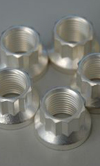Silver plating of fasteners
 The matter of selecting the correct material for fasteners is an important one. The design engineer or engine development specialist has to be sure that the material is strong enough to resist the applied loads and have the fatigue resistance to continue in its role between engine rebuilds. There are a huge number of materials offered by manufacturers of fasteners depending on the application, service loads, environment and so on.
The matter of selecting the correct material for fasteners is an important one. The design engineer or engine development specialist has to be sure that the material is strong enough to resist the applied loads and have the fatigue resistance to continue in its role between engine rebuilds. There are a huge number of materials offered by manufacturers of fasteners depending on the application, service loads, environment and so on.
The job of those working with internal combustion engines is made simpler by the fact that the service temperatures for most fasteners are moderate. Moreover, the environment in which the fasteners operate - certainly in terms of the chemicals present - is quite benign. Most coated fasteners are zinc-plated or chromium-plated, or to a much lesser extent recently, cadmium. Cadmium is generally frowned upon nowadays owing to environmental concerns, and processes involving chromium are increasingly under the spotlight, as certain forms of chromium are also judged to be bad for the environment.
There are certain applications however where temperature is a real concern. Exhaust systems are the main example, especially where turbochargers are employed. The use of standard steel fasteners can lead to seizure and breakage, as was discussed in a previous RET monitor article. It is also common to use a fastener in a high-temperature material that also employs a coating material which will not degrade at elevated temperature.
It is normal to use a stud-and-nut combination for exhausts. There is less imperative to use a high-temperature material for the stud as it is generally well cooled at one end, being installed in a comparatively cool cylinder head. The nut material needs to be chosen such that it will not weaken in use due to high temperature.
The plating chosen is commonly silver. Silver-plated fasteners are widely used in industry where lubricant cannot be used or where fasteners are assembled into materials where galling is a serious risk. Silver plating is very soft and has very low shear strength, and so acts as a solid lubricant, lowering the coefficient of friction where it is used dry. This means that less torque is required to produce a given level of preload, and this means that a stress is induced in the fastener during tightening. Silver also has the advantage in that it doesn't oxidise significantly at temperature, making it ideal for exhaust use.
Silver-plated nuts are also used in some applications where high loads make it difficult for lubricants to remain in highly loaded parts of the contact. In these instances a low-shear strength coating such as silver can be beneficial. Such is the effectiveness of silver as a lubricant that there are a number of silver-doped pastes and greases available commercially.
Silver-plated nuts are widely available commercially from motorsport and aerospace outlets, in free-running and self-locking styles, but if these aren't available or you need something special, industrial silver plating is also widely available from surface treatment specialists. Industrial silver plating is not however the same process as the treatment you might see on cheap jewellery, as you can see from the accompanying picture.
Fig. 1 - These 12-point nuts are silver plated
Written by Wayne Ward